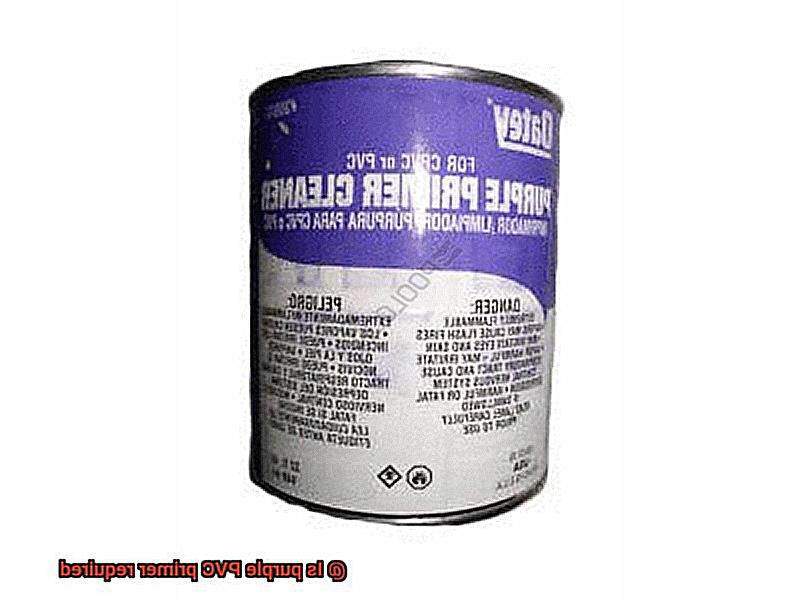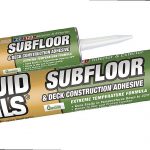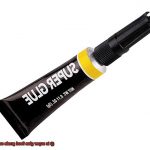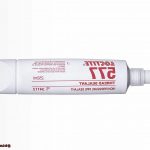Step right into the captivating world of PVC primer.
Picture this: you’re knee-deep in a plumbing project, armed with your trusty PVC glue, when you spot a small, vibrant bottle standing out from the crowd – the infamous purple PVC primer. Cue the question that’s been nagging at you: is this flashy liquid really necessary?
Fear not, because we’re here to uncover the truth behind this colorful debate. Together, we’ll unravel the role of purple PVC primer in connecting pipes, discover its undeniable importance in ensuring a rock-solid bond, and determine whether it’s just an extra precaution or an absolute must-have.
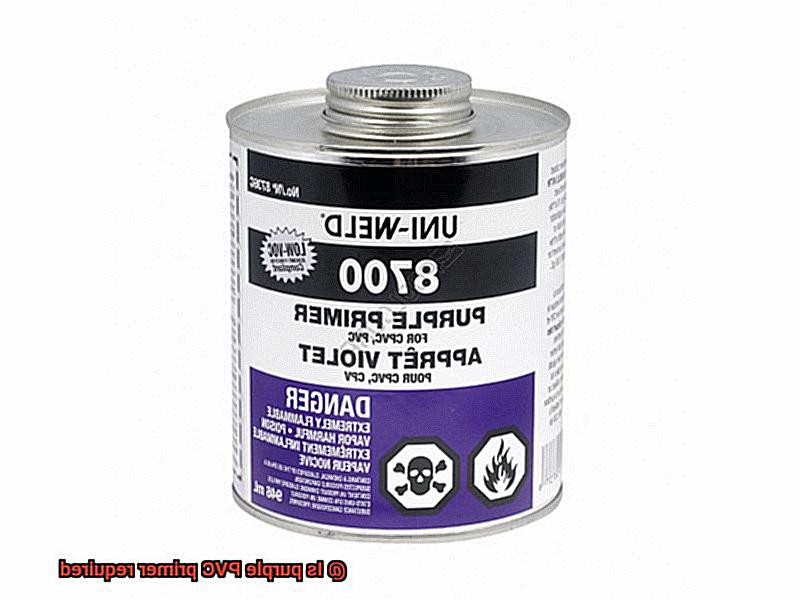
Get ready to dive deep into the mysteries of this vibrant elixir – and prepare to be amazed.
What is Purple PVC Primer?
Contents
- 1 What is Purple PVC Primer?
- 2 Why is Purple PVC Primer Used?
- 3 The Benefits of Using Purple PVC Primer
- 4 When Is the Use of Purple PVC Primer Necessary?
- 5 What Are the Risks of Not Using Purple PVC Primer?
- 6 How to Properly Apply and Use Purple PVC Primer
- 7 Alternatives to Using Purple PVC Primer
- 8 Conclusion
When it comes to creating durable connections between PVC pipes and fittings, one tool stands out in its mission to provide strength and reliability: purple PVC primer. In this article, we will delve into the world of purple PVC primer, exploring its purpose, unique features, and why it is an indispensable component in any PVC pipe installation.
Unveiling the Essence of Purple PVC Primer:
Purple PVC primer is a liquid adhesive solution formulated exclusively for use with PVC pipes and fittings. It serves as a preparatory agent, ensuring an unbreakable bond between the pipe and the cement used to join them.
The Dynamic Purpose of Purple PVC Primer:
- Surface Preparation: Before the application of PVC cement, purple PVC primer sweeps onto the stage, ready to clean and soften the surface of the PVC pipes and fittings. It banishes dirt, contaminants, or residues that could hinder the bonding process, paving the way for impeccable adhesion.
- Amplifying Bonding Strength: The secret behind the captivating performance of purple PVC primer lies in its chemical composition. Solvents, stabilizers, and other additives harmoniously collaborate to amplify the bond between the pipe and the cement. This extraordinary synergy results in a joint that can withstand intense pressure and stress, ensuring longevity and reliability.
- The Mesmerizing Indicator: Behold. The enchanting purple hue of this primer is not just for aesthetics. It possesses a hidden power—a visual cue that guides us through the installation process. As the primer dries, its color magically transforms into a translucent or clear finish. This spellbinding metamorphosis signifies that the primer has evaporated, indicating that the surface is primed and ready for the application of PVC cement.
When is Purple PVC Primer Required?
Though not mandatory in all cases, using purple PVC primer is highly recommended in most PVC pipe installations. Pipe size, application, and local building codes are key factors that determine whether its presence is required or optional.
To unravel the mystery of purple PVC primer’s necessity in your specific installation, consulting local building codes and manufacturer recommendations is paramount.
Conclusion:
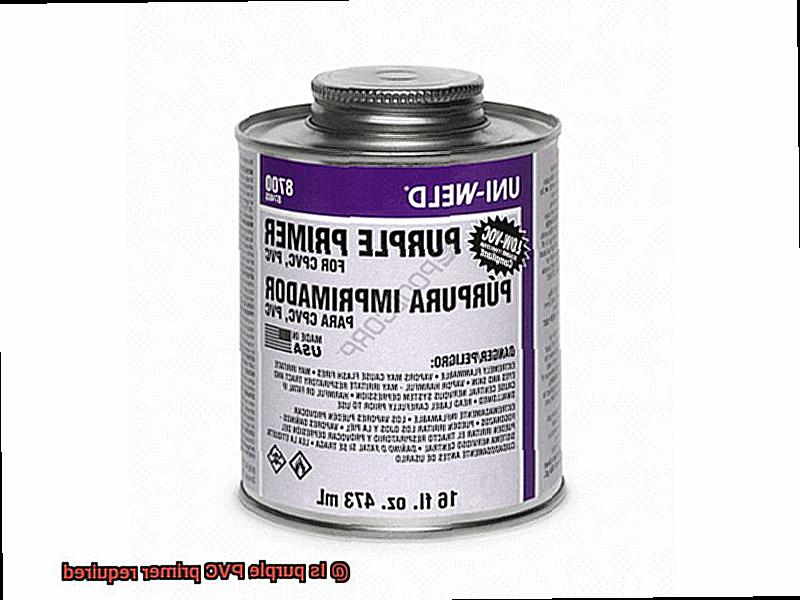
Purple PVC primer takes center stage in delivering robust and dependable connections in PVC pipe installations. Its surface preparation properties and bonding enhancement capabilities guarantee a joint that can conquer the challenges of diverse applications.
Why is Purple PVC Primer Used?
If you’ve ever wondered why this vibrant purple potion is an essential part of joining PVC pipes and fittings together, then get ready for some enlightening information.
First and foremost, let’s talk about how purple PVC primer acts as the ultimate clean-up crew for your pipes. Picture this: PVC pipes and fittings often come with a glossy or smooth surface, which makes it challenging for adhesive to stick properly. But fear not. The purple primer swoops in to save the day. It contains special chemicals that roughen up the surface of the PVC, creating a textured landscape that the adhesive can grip onto like a rock climber on a challenging wall.
But wait, there’s more. This magical potion also has the power to soften the PVC material itself. By gently softening the outer layer of the PVC, the primer allows the adhesive to penetrate deep into the material, creating a bond that’s as strong as a superhero’s grip.
And that’s not all. Purple PVC primer is not only a cleaner and softener but also a protector. It acts as a solvent, dissolving any dirt, grease, or other contaminants that might be lurking on your pipes’ surfaces. By removing these pesky impurities, the primer ensures that nothing gets in the way of your pipe joints’ strength and reliability.
Now, here’s a bonus feature for all you visual learners out there. The vibrant purple color of this primer serves as a handy visual indicator during the installation process. Imagine having to connect multiple joints in a large-scale project – it can get pretty overwhelming. But fear not, because that vivid purple hue helps ensure that every inch of your pipes has been properly primed before applying the adhesive. It’s like having a trusty sidekick guiding you along the way.
But remember, not all PVC pipe installations require purple PVC primer. Some adhesives may have specific primers recommended by the manufacturer or may not require primer at all. So, always double-check the instructions and guidelines before you dive into a new project.
So, there you have it, my curious friends. Purple PVC primer may seem like a humble potion, but it plays a vital role in creating secure and long-lasting PVC pipe joints. It cleans, prepares, softens, protects, and even serves as a visual guide during the installation process. With purple PVC primer by your side, you can glue those pipes together with confidence and ensure that your plumbing projects stand the test of time.
The Benefits of Using Purple PVC Primer
When it comes to plumbing projects, strong and durable pipe joints are essential. Purple PVC primer may not be mandatory in all plumbing codes, but its benefits make it a wise choice for any PVC pipe installation. Let’s explore the key advantages of using purple PVC primer and why it should be an essential part of your plumbing toolkit.
Ensures a Strong Bond:
Purple PVC primer acts as a crucial foundation for creating a robust connection between pipes and fittings. By softening and cleaning the surface of the PVC material, it prepares it for the adhesive or cement that will be applied later. This step eliminates dirt, grease, and debris, ensuring optimal adhesion. The result? A stronger bond between the pipe and fitting that minimizes the risk of leaks or failures.
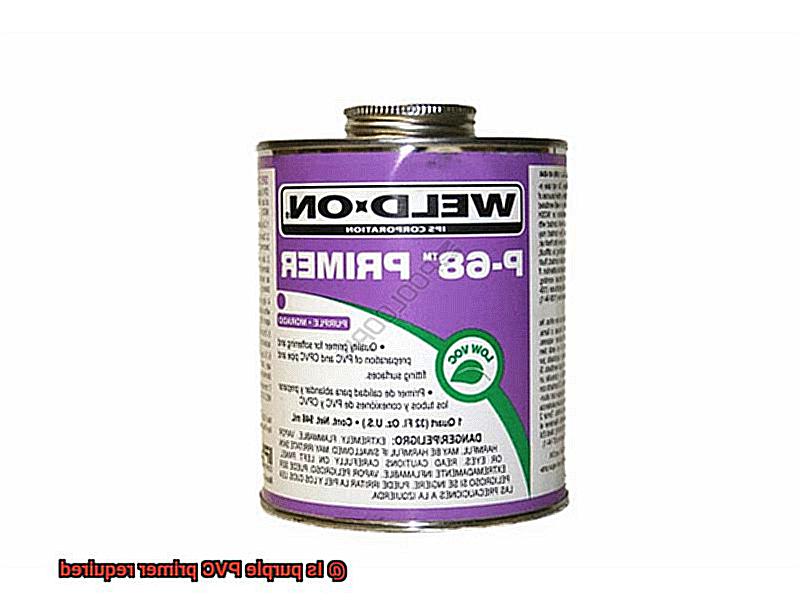
Enhances Longevity:
PVC pipes are subject to various environmental factors that can weaken joints over time. Purple PVC primer acts as a protective barrier, safeguarding connections against temperature changes, water pressure, and chemical exposure. By applying the primer before cementing the joint, you significantly enhance its durability, preventing potential issues down the line.
Provides Visual Assurance:
The distinct purple color of the primer serves as a visual cue that each joint has been properly primed before cementing. This simple yet effective feature allows plumbers and inspectors to easily identify if all necessary steps have been followed during installation. With purple PVC primer, you can ensure quality control and avoid future problems, providing peace of mind for professionals and homeowners alike.
Offers Convenience:
Time is precious in plumbing projects, especially when multiple joints need to be primed within a short period. Purple PVC primer dries quickly, allowing for swift application and reducing waiting time before applying the adhesive or cement. Its compatibility with various types of PVC pipes and fittings makes it a versatile choice for different plumbing projects.
When Is the Use of Purple PVC Primer Necessary?
If you’ve ever embarked on a PVC pipe project, you may have come across a mysterious purple liquid called PVC primer. While it may seem like an optional step in the process, using purple PVC primer can actually make a world of difference in the strength and durability of your pipe joints. In this article, we’ll dive into when exactly the use of purple PVC primer is necessary and why it should be a staple in your plumbing arsenal.
Type of PVC Matters:
Not all PVC pipes and fittings are created equal. Purple PVC primer is especially crucial when working with CPVC (chlorinated polyvinyl chloride) pipes and fittings. CPVC is designed to withstand higher temperatures and pressures, making proper priming essential for a strong bond. So, if you’re dealing with CPVC, don’t skip the purple primer.
Extreme Conditions Call for Extra Measures:
If your PVC installation is going to be exposed to extreme temperatures or harsh environmental conditions, purple PVC primer becomes even more crucial. It acts as a protective layer, ensuring that your pipe joints remain strong and leak-free, no matter what Mother Nature throws at them.
Size Matters:
When it comes to larger diameter pipes, using purple PVC primer is highly recommended. The larger surface area requires more adhesive strength, which can be achieved through proper priming. So, if you’re working with pipes that have a diameter greater than 2 inches, reach for that purple primer for added security.
Visual Assurance and Compliance:
In addition to its practical benefits, purple PVC primer offers visual assurance that the primed surfaces are ready for cement application. This makes it easier to ensure that every joint has been properly prepared before moving forward with the project. Furthermore, some local building codes or regulations may require the use of purple PVC primer in certain situations. Checking with your local authorities ensures compliance and avoids potential headaches later on.
What Are the Risks of Not Using Purple PVC Primer?
It’s not just a fancy color – it’s a vital step in joining PVC pipes and fittings. Skipping purple PVC primer might seem like a shortcut, but it can lead to a world of trouble. Let’s explore the risks of forgoing this superhero primer and why glue alone won’t suffice.
Weak Connections:
Without purple PVC primer, the glue may fail to establish a strong bond between the pipe and fitting. This spells trouble, as leaks, breaks, and water damage are bound to follow – the last thing you want after completing your plumbing project.
Diminished Durability:
Your plumbing system faces temperature changes and pressure fluctuations daily. By skipping the primer step, you compromise the joint’s durability. Over time, this can result in cracks or fractures, necessitating even costlier repairs down the line.
Debris and Contaminants:
Purple PVC primer acts as a cleaning agent, eliminating dirt and contaminants from the PVC surface. By neglecting this step, particles hinder the bonding process and weaken connections.
Voided Warranties:
Manufacturers often mandate using purple PVC primer to maintain warranty coverage. If you skip this crucial step and encounter issues with your piping system, you may find yourself without any support or assistance from the manufacturer.
Non-Compliance with Building Codes:
Building codes exist to ensure plumbing system safety and functionality. Many jurisdictions require purple PVC primer during installation. Failing to comply with these codes can result in fines, penalties, and potential difficulties when selling or insuring your property.
How to Properly Apply and Use Purple PVC Primer
When it comes to joining PVC pipes and fittings, creating a strong and reliable bond is essential. Purple PVC primer is a vital tool in achieving this goal. In this guide, we will walk you through the proper application and use of purple PVC primer, empowering you to create secure connections that will stand the test of time.
Prepare the Surface:
To ensure a successful bond, start by preparing the PVC surfaces. Wipe away any debris or dirt using a clean cloth or rag. For stubborn stains, use a mild detergent and rinse thoroughly. Allow the PVC to dry completely before moving on.
Shake Well:
Before applying purple PVC primer, shake the can vigorously. This shaking action helps mix any settled particles and ensures an even distribution of primer during application.
Apply Thin and Even Coat:
Using a brush or applicator, apply a thin and even coat of purple PVC primer to both the inside of the fitting and the outside of the pipe. Avoid oversaturating the material; a thin coat is sufficient to prepare the surface for bonding.
Allow Drying Time:
After applying the primer, give it time to dry according to the manufacturer’s instructions. Drying times may vary depending on temperature and humidity levels. It’s crucial not to let the primer dry completely before applying the adhesive.
Apply Adhesive:
Once the purple PVC primer has dried, it’s time to apply the adhesive or glue. Apply a thin layer of adhesive to both surfaces that will be joined – inside the fitting and outside the pipe.
Join and Twist:
After applying the adhesive, quickly join the PVC pipes or fittings together while giving them a slight twist. This twisting motion helps evenly distribute the adhesive, ensuring a tight and secure bond. Hold the pieces together for a few seconds to allow the adhesive to set.
Alternatives to Using Purple PVC Primer
For years, purple PVC primer has been the go-to choice for bonding PVC pipes and fittings. However, did you know that there are alternative options available that can provide similar results without the unsightly purple stain? In this article, we will embark on a colorful journey together, exploring alternatives to purple PVC primer and their potential benefits and applications.
Clear or Transparent Primer:
One alternative to purple PVC primer is using a clear or transparent primer. This type of primer functions similarly to its purple counterpart but leaves behind no unsightly residue. Clear primers are particularly popular in applications where aesthetics matter, such as visible plumbing installations or decorative projects. With a clear primer, you can achieve a strong bond without compromising the visual appeal.
Self-Priming PVC Glue:
Imagine a world where you don’t need a separate primer. Enter self-priming PVC glue. This innovative adhesive eliminates the need for a separate primer by incorporating priming properties within the glue itself. Not only does this save you time and effort during installation, but it also streamlines the process while maintaining strong connections. Say goodbye to the extra step of applying primer with self-priming PVC glue.
All-in-One PVC Cement:
Simplify your bonding process with all-in-one PVC cement. Some manufacturers offer products that combine the properties of both primer and glue into one convenient product. This streamlined approach is ideal for DIY enthusiasts or professionals looking for a hassle-free experience. With all-in-one PVC cement, you can achieve a strong bond while enjoying ultimate convenience.
Important Considerations:
While these alternatives present exciting possibilities, it is crucial to remember that not all applications may be suitable for them. Always refer to manufacturer guidelines and consult with professionals to ensure compatibility and safety with your chosen alternative method.
Moreover, compliance with local building codes and regulations is of utmost importance to ensure the longevity and reliability of your PVC pipe installation. Take the time to familiarize yourself with these guidelines, protecting both your project and those who will benefit from its functionality.
Conclusion
Purple PVC primer is an indispensable ingredient for establishing sturdy and long-lasting connections in PVC pipe installations. Its significance extends beyond mere aesthetics, as it acts as a preparatory agent that purifies, softens, and readies the surface of PVC pipes and fittings for bonding. By doing so, this primer fortifies the bond between the pipe and the cement used to unite them, guaranteeing durability and dependability.
Though not always obligatory, purple PVC primer comes highly recommended for most PVC pipe installations. Various factors such as pipe size, application, and local building codes dictate whether its usage is mandatory or discretionary. To demystify the necessity of purple PVC primer in your specific installation, it is crucial to consult local building codes and adhere to manufacturer recommendations.
The advantages of incorporating purple PVC primer into your projects are manifold. It ensures a robust bond that withstands the test of time while enhancing longevity. Moreover, it provides visual confirmation during installation and offers convenience with its rapid drying times. Conversely, neglecting to use purple PVC primer can result in feeble connections, diminished durability, accumulation of debris, voided warranties, and non-compliance with building codes.
To apply purple PVC primer correctly, begin by meticulously cleansing the surface before applying a thin and even layer of primer. Allow sufficient time for drying before proceeding to join the pipes or fittings together using adhesive.
While alternatives like clear or transparent primers, self-priming PVC glue, or all-in-one PVC cement do exist, it is imperative to assess their suitability for specific applications and ensure compliance with local building codes.
In conclusion, integrating purple PVC primer into your plumbing endeavors guarantees secure connections that will endure over time.

